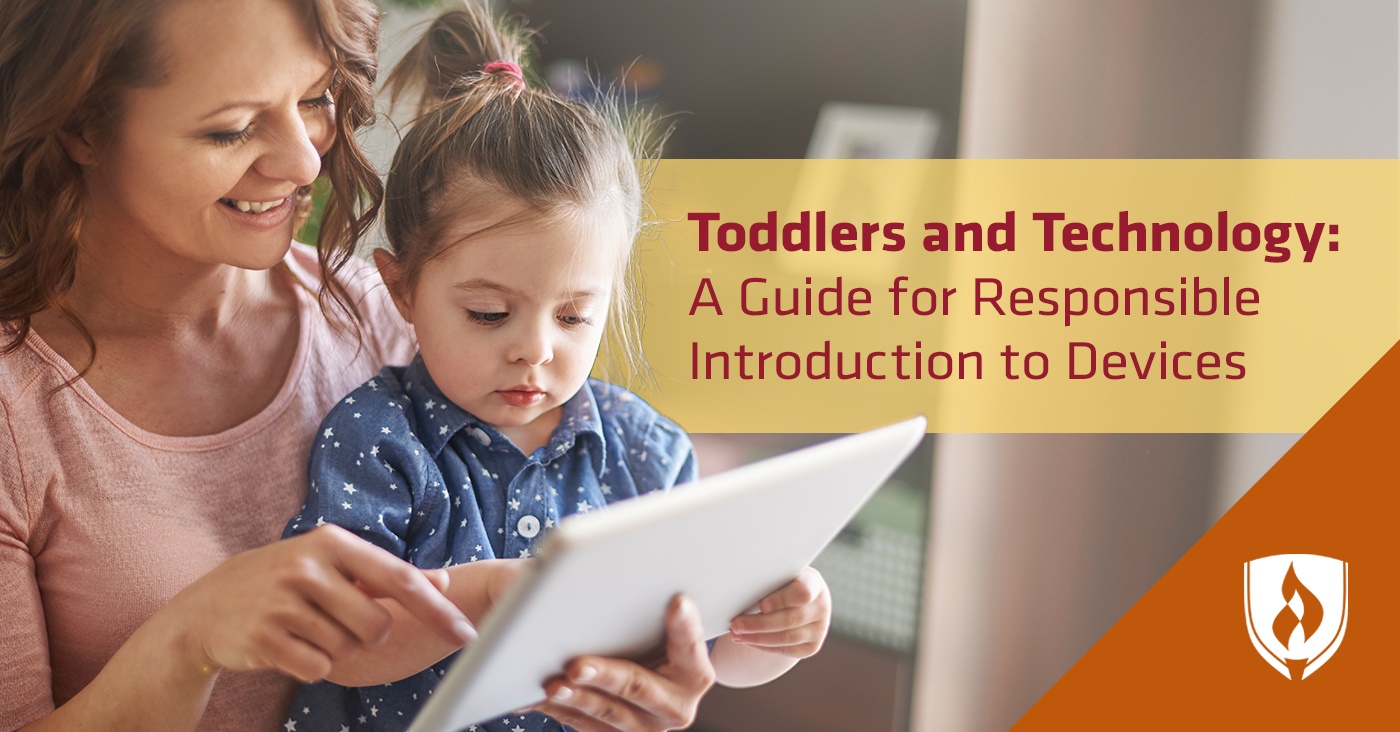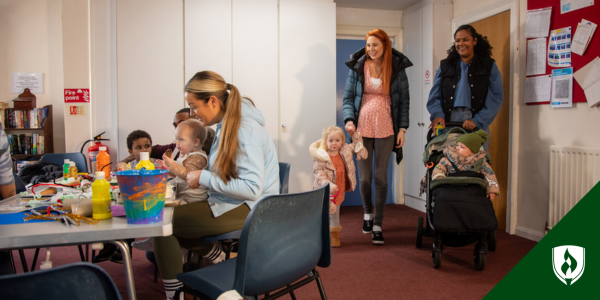Toddlers and Technology: A Guide for Responsible Introduction to Devices
By Anjali Stenquist on 10/12/2020

The use of high-tech devices has influenced almost every part of our lives in 2020. There is a good chance you’re reading this article on a smartphone or tablet right now. While there is no denying the positive influence of technology on our ability to work remotely, remain connected with loved ones, and stay up to date on everything from the chance of rain over the weekend to local and global news, it is important to think through how this combination of living in the three dimensions of the real world and the two dimensions of a high-tech touch screen impacts the development of young children.
Maybe you’ve seen a young child use the two-finger “zoom” gesture on a kitchen window hoping to get a better view, or poke a still image expecting it to be interactive. While these examples are amusing, it does show how technology can alter a child’s perception of the natural world.
Is that cause for concern? It might be too early to definitively say one way or another, but it’s still important to take the time to understand the implications and best practices around developing a healthy, positive relationship between a toddler and technology. Technology is a tool, and like any tool, the way we use it has far more impact than any innate quality of the tool itself.
What are the effects of technology use among toddlers?
In the last five years, the American Academy of Pediatrics (AAP) has conducted research and held symposiums on the use of technology among children and its influence on their health and development. Though much of this research is ongoing and the way we used technology in 2015 has evolved somewhat, the AAP has put together a valuable set of information around the impact of technology and early childhood development.
Many children are able to use a touch screen before the age of one. By 3 or 4, nearly 97 percent are able to effectively navigate mobile devices.1 The long-term impact on this type of technology use is genuinely unknown. That said, the APA has identified three areas of concern around the use of high-tech devices by young children.
Language development
Young children learn language most effectively through interactions. Children under 12 months struggle to learn language from a video, and though by 12-24 months they are able to learn from “passive” or non-interactive language such as television, it is far less effective than in person and live conversation.2 A toddler who spends a significant amount of time watching television or other media is likely to experience linguistic delays. Use of video chat has not been shown to limit linguistic development because of the interactive nature of a conversation even if it happens on a screen.
Obesity
Early media use has been linked to obesity.3 Some potential causes include food advertising and eating food while watching media, which limits the body’s ability to effectively communicate cues around hunger and fullness. A study on 2-year-olds found that BMI (body mass index, a commonly used measure of weight in relationship to height) increased for every hour per week of media consumed.4
Sleep
Exposure to a television, computer, or mobile device in a child’s bedroom has been linked to fewer minutes of sleep per night.5 Sleep is critical for early childhood development and a lack of sleep can impact everything from a child’s immune system to cognitive and emotional health.
How do you use technology safely with young children?
Despite these concerns, it is almost inevitable that a young child will interact with technology and new media with some frequency. So how do you plan for the best possible relationship between a toddler and technology? We’ve put together 7 simple guidelines to create a healthy balance around toddlers and tech.
7 Simple guidelines for young children and new media
1. Model healthy screen use
The best way to help a child develop healthy habits around technology use is to demonstrate them yourself. You may find your own relationship with your smartphone is a little more complicated than you thought—but showing healthy boundaries around when and where you use technology will go a long way in helping a child integrate those behaviors throughout their life.
2. Be an active participant in your child’s screen time
Toddlers are constantly learning and observing. Particularly around linguistic and social learning, it is critical that young children have the opportunity to interact with adults. While parking a young child in front of a screen has been shown to limit development, interacting with a child while they take in some form of media can help them learn and develop. Do your best to make the time spent on a device quality time—ask questions, lead the conversation and enrich the experience whenever possible.
3. Do your best to follow recommended time limits
In 2016, AAP developed evidence-based recommendations for children’s media use. You can read the full set of recommendations here. Most notably, the AAP strongly recommends that children under 18 months only use screen media for video chatting and children 2-5 years should limit screen use to 1 hour per day with an adult caregiver to help them interpret and understand what they are viewing. Like with a lot of guilty pleasures, moderation is key. Will there be days where you’re outside of that range? Almost definitely—but the key is to make that the exception, not the standard.
4. Be skeptical of “educational” apps
App stores have a fairly broad definition of what they label as educational, and many of these “educational” apps have no demonstrated educational value. Take the time to vet any apps your child may use. Does this app actually reinforce foundational child development needs like refining motor skills, developing vocabulary or how to process feelings and emotions? Or is it merely offering a brightly colored stimulus reward for pressing a button?
5. Create intentionally tech-free times and spaces
Make meals or driving media-free times. Provide areas in the home where technology is not allowed. This will give young children grounding spaces in the three dimensional, “real” world to balance the stimulation and engagement of technology with their other sensory-based learning and play. This doesn’t have to feel like a punishment, either. You can make the “play” room a device free area that’s still full of fun toys and activities that are developmentally appropriate.
6. Be aware of the potential to confuse and overstimulate your toddler
Often things that are made for children are packed to the brim with over-the-top stimuli that really don’t need to be there. For instance, e-books can be a wonderful way of reading with young children. However, many e-books may also come with additional programming that has been shown to confuse or distract toddlers and limit the positive impact of reading with young children. Treat e-books like regular books and keep in mind that more stimulation is not always better when it comes to enriching your child’s environment.
7. Create a family media plan
The AAP has developed an online tool to help your family create a family media plan. Taking the time to intentionally create guidelines around technology use at home can help you build a more mindful relationship to your own media use as well as limit conflict around media use down the line. The family media plan includes creating screen-free times, balancing online and off-line time and planning for safety and good digital citizenship. The AAP has developed this tool from extensive research and has links to more information on the ideas behind the family media plan if you are interested in learning more.
Grow your understanding of child development
Technology and devices obviously aren’t the only factor that can influence the healthy development of a young learner. Parents, teachers and caregivers can all be steady forces for good if equipped with the right approach and know-how to help. If you’re looking to continue growing your understanding of child development, check out our article, “Understanding the Stages of Emotional Development in Children” to learn more about another crucial subject.
1American Academy of Pediatrics, Pediatrics, Exposure and use of mobile media devices by young children, [accessed September, 2020] https://pediatrics.aappublications.org/content/136/6/1044
2Proceedings of the National Academy of Sciences of the United States of America, Foreign- language experience in infancy: Efforts of short term exposure and social interaction on phonetic learning, [accessed September, 2020] https://www.ncbi.nlm.nih.gov/pmc/articles/PMC166444/
3Health Promotion Journal of Australia, Television viewing, television content, food intake, physical activity and body mass index: a cross-sectional study of preschool children aged 2-6 years. [accessed September, 2020] https://pubmed.ncbi.nlm.nih.gov/22730942/
4The Obesity Society, Obesity, Correlates of body mass index and overweight and obesity of children aged 2 years: findings from the healthy beginnings trial. [accessed September, 2020] https://pubmed.ncbi.nlm.nih.gov/24415528/
5American Academy of Pediatrics, Pediatrics, Television viewing, bedroom television, and sleep duration from infancy to mid-childhood. [accessed September, 2020] www.pediatrics.org/cgi/content/full/133/5/e1163




